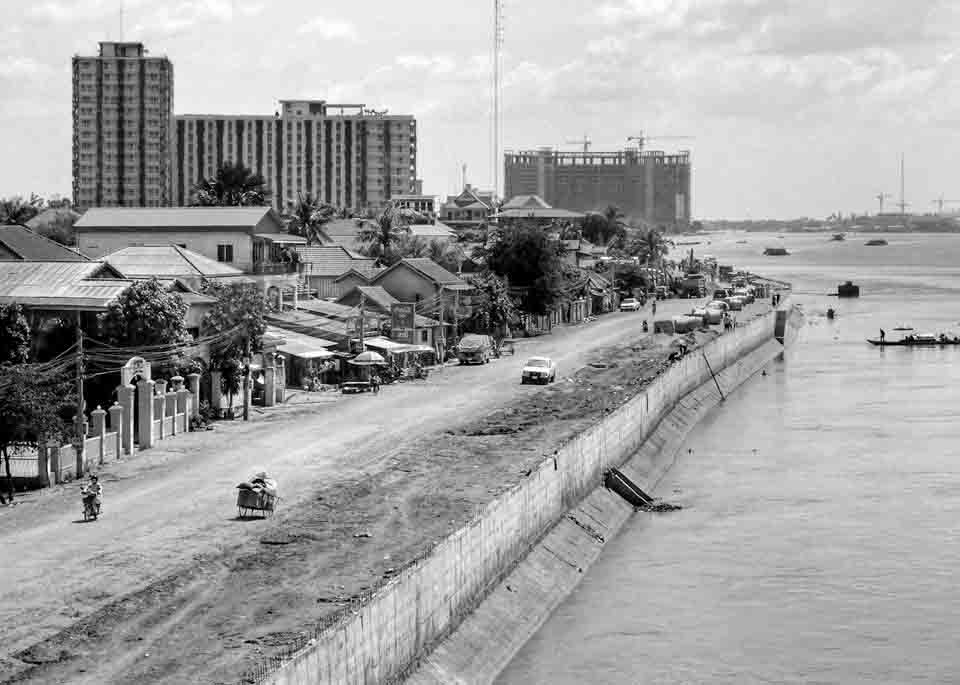Phnom Penh was the ultimate low-rise Asian capital before the money came flooding in. A de facto building code ensured that no structure could reach higher than Wat Phnom. Streets in most areas resembled lunar terrain, the bitumen scarred with truck-eating potholes that flooded femur-deep in the rainy season.
Before the Korean speculators and tsunami of repatriated dollars came gushing back, Phnom Penh was still very much an unassuming provincial outpost as sleepy as any town upriver. The hammers started pounding about 2004. And save for a lull following the 2008 property bubble explosion they have never stopped, as the endless symphonies of metal grinders and demolition teams attest.
Photographer Jeff Perigois settled into the city in January 2002. His exhibit at The FCC, entitled Evolution, is a then-and-now perspective of the changing cityscapes that have redefined the capital over the last 10 years. Evolution is neither a nostalgic look nor one particularly loaded with political undertones. “I am just a witness,” Perigois says of the work.
Of the 70 or so photographs, nearly half are displayed in pairs: a shot from the pre-boom days paired with a more recent perspective. None are more striking than the two looking south from the far end of the Chroy Changvar Bridge. In 2009, a long row of stilted, tin-roof shanties lined an overgrown riverbank. A ribbon of loose stone traced the water’s edge and, in the distance, skinny red-and-white radio towers pierced the sky.
By November this year the homes were all gone, replaced by the construction of a wide boulevard and sophisticated drainage project. A two-metre-high retaining wall kept it all from collapsing into the river below. Massive multi-storey developments crowded the skyline.
Central Market makes an appearance: before, an aging, water-stained relic with deteriorating paint and sagging umbrellas out front; after, a monotone deco icon with artsy steel and concrete awnings. “The Chinese offered to tear it down and build a huge modern shopping centre,” Perigois says. “The French government had a fit and sent the money to remake it right away.”
The unpaired half of Evolution is Perigois’ survey of Phnom Penh here and now. There is La Siene on Koh Pich, an architectural stand-in for the riverscape in Paris; the desert of a lake at Boeung Kak; demolished plywood shacks crumbled at the foot of skyscrapers. “I wanted to show that to build something new, something old must be destroyed.”
Destruction and rebirth seem constant themes in the capital. Each new development begets yet another, each greater and more grandeur than the previous. “What is the real evolution of Phnom Penh?” Perigois asks. “It’s not the small spots we see in town, because now the evolution of Cambodia is huge. The city has grown tremendously. It’s totally incredible what they are building for the next five or 10 years.”
With every new red brick laid, every new shopping mall christened, Phnom Penh as ‘sleepy little capital’ fades further and further from memory. “When we live in the city day by day, of course we see some changes, we see new buildings rise,” Perigois says, “but what was there before? A lot of people forget.”
WHO: Jeff Perigois
WHAT: Evolution, a photographic then-and-now look at Phnom Penh
WHERE: The FCC, Sisowath Quay
WHEN: December 21 to January 31
WHY: Photography, nostalgia and booze
